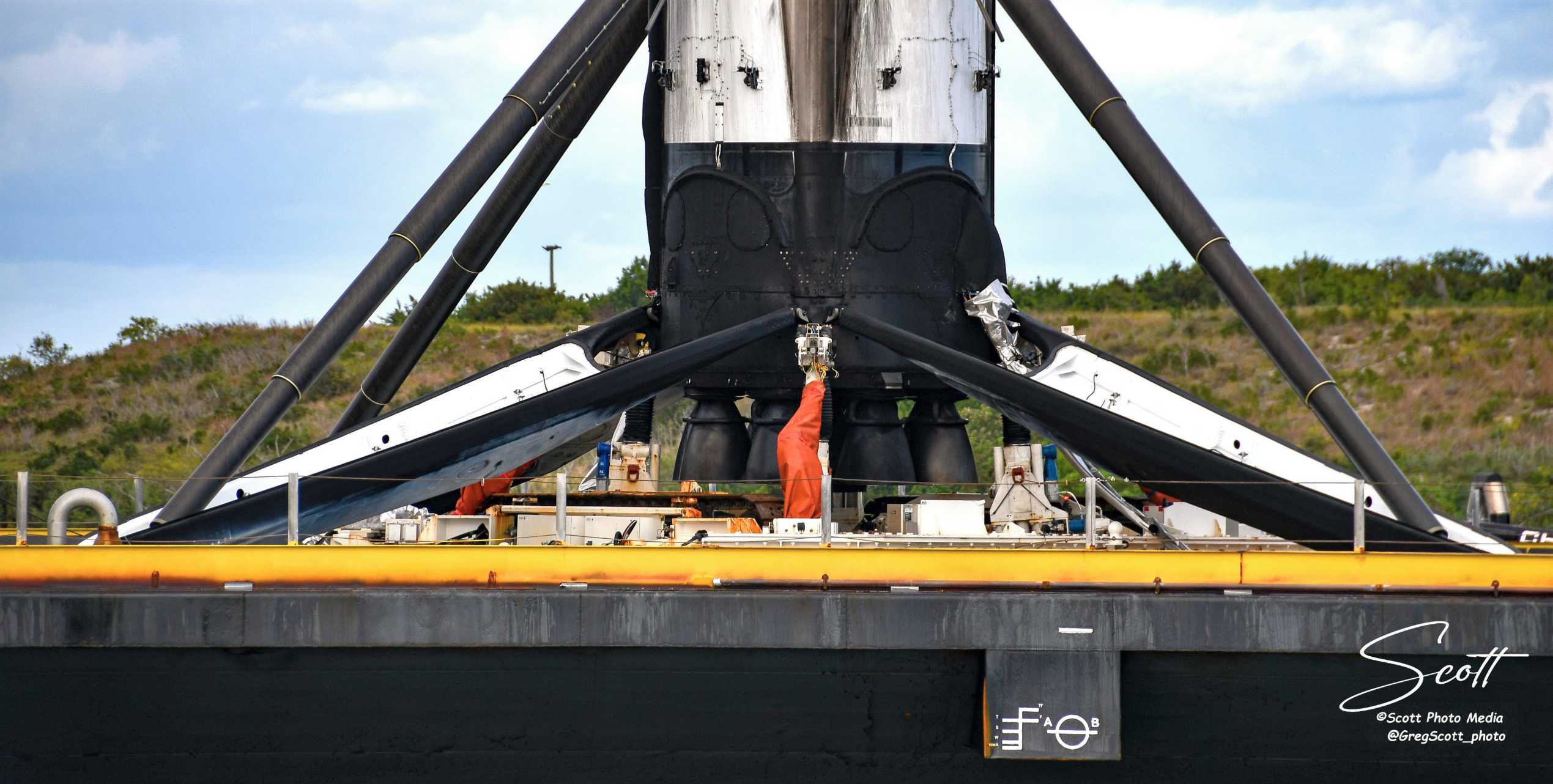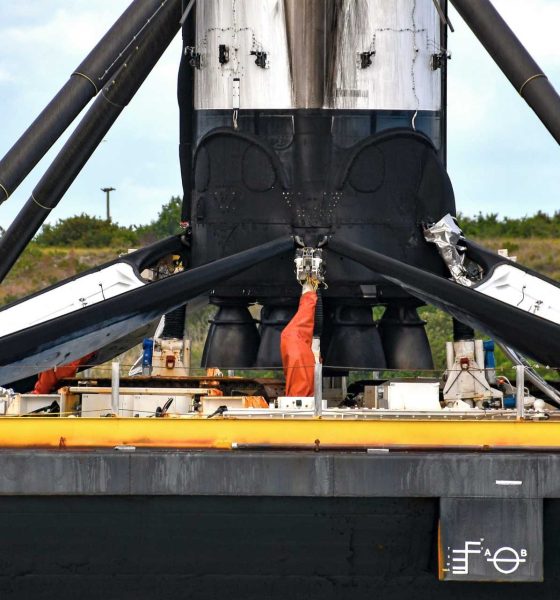

News
SpaceX wraps up a decade of reusable rocketry with fastest booster recovery yet
SpaceX has completed its 13th and final launch and landing of the year and decade, marked by a Falcon 9 booster’s successful return to Port Canaveral and subsequent processing to prepare it for another orbital-class mission.
Over the course of that recovery, SpaceX broke the record for the fastest Falcon 9 processing by several hours, a small but significant step towards the company’s ultimate goal of launching and landing the same Falcon 9 booster in less than 24 hours. Additionally, SpaceX appears to have finished processing booster B1056 on December 21st, the 4th anniversary of Falcon 9’s first successful landing after an orbital-class launch.
Since that first success on December 21st, 2015, SpaceX has rapidly moved through several distinct iterations of Falcon hardware, constantly improving components, systems, and the overall fit, finish, and reliability of the rocket. Over the last four years, SpaceX has landed an incredible 47 Falcon 9 and Falcon Heavy boosters as part of 60 orbital-class launches, while the company recently launched Falcon 9 B1048 for the fourth time and flew the same two Falcon Heavy boosters in April and June. Ultimately, 2019 has been a spectacularly successful year for SpaceX, and – by the numbers – 2020 is set to be several times more ambitious, still.
On December 20th, less than a day after arriving in Port Canaveral, SpaceX technicians began the process of retracting Falcon 9 booster B1056’s four deployed landing legs. As it turns out, B1056 – returning to port for the second time after its third launch – became the first Falcon 9 booster to have all of its landing legs successfully (and semi-permanently) retracted in May 2019. To accomplish the feat, SpaceX designed a custom retraction mechanism that simultaneously serves as the crane jig used to lift the booster while vertical.
“The crux of the need for a relatively complex crane-and-jig method of leg retraction rests on SpaceX’s landing leg design. Put simply, after rapidly deploying with a combination of gravity and hydraulics, Falcon 9 landing legs have no built-in way to return to their stowed state. Each of the four legs are quite large, weighing around 600 kg (1300 lb) and stretching about 10m (33 ft) from hinge to tip. They use an intricate telescoping carbon fiber deployment mechanism to give them legs enough strength to stand up to the stresses of Falcon 9 booster landings.
Combined, the legs’ size and telescoping mechanism makes the addition of an onboard retraction mechanism impractical. All the needed hardware would struggle to find a good place for installation and would quite literally be dead weight during launches and landings, stealing from Falcon 9/Heavy payload capacity and generally serving no purpose until a booster has been lifted off the ground with a giant crane.”
Teslarati — May 7th, 2019
Impressively, SpaceX took less than an hour and a half to successfully retract all four of thrice-flown Falcon 9 B1056’s also thrice-flown landing legs. Less than three hours after the rocket’s legs were snugly retracted, SpaceX immediately attached a second crane and brought the booster horizontal. Altogether, this made Falcon 9 B1056’s third recovery the fastest SpaceX has ever performed by 3-6 hours – seemingly small progress but still no mean feat.
SpaceX’s fastest-ever Falcon 9 recovery – from the drone ship berthing to the booster departing the port on a transporter – occurred with B1049 after its third launch and landing, taking just 2.01 days (48.25 hours). Falcon 9 B1056’s third recovery appears to have beaten that record by at least several hours, brought horizontal and installed on a SpaceX transporter perhaps less than 1.75 days (42 hours) after arriving in port – more than 10% faster than B1049’s previous record.
Meanwhile, SpaceX lifted a fairing half recovered off the surface of the Atlantic Ocean by GO Ms. Tree, appearing unharmed after having potentially been dropped when the ship’s secondary (fairing) fishing net tore while moving the Falcon 9 hardware.
With any luck, that fairing half will be in good enough shape to be reused on a future Starlink mission, seemingly unlikely but proven to be well within the realm of possibility after SpaceX’s very first fairing reuse involved two halves recovered off the ocean surface after Falcon Heavy Block 5’s April 2019 debut. B1056, however, is all but guaranteed to fly again – this time on its fourth launch – in the near future. SpaceX has dozens of launches planned in 2020, so there will be plenty of opportunities.
Check out Teslarati’s Marketplace! We offer Tesla accessories, including for the Tesla Cybertruck and Tesla Model 3.

News
Elon Musk’s Grokipedia surges to 5.6M articles, almost 79% of English Wikipedia
The explosive growth marks a major milestone for the AI-powered online encyclopedia, which was launched by Elon Musk’s xAI just months ago.

Elon Musk’s Grokipedia has grown to an impressive 5,615,201 articles as of today, closing in on 79% of the English Wikipedia’s current total of 7,119,376 articles.
The explosive growth marks a major milestone for the AI-powered online encyclopedia, which was launched by Elon Musk’s xAI just months ago. Needless to say, it would only be a matter of time before Grokipedia exceeds English Wikipedia in sheer volume.
Grokipedia’s rapid growth
xAI’s vision for Grokipedia emphasizes neutrality, while Grok’s reasoning capabilities allow for fast drafting and fact-checking. When Elon Musk announced the initiative in late September 2025, he noted that Grokipedia would be an improvement to Wikipedia because it would be designed to avoid bias.
At the time, Musk noted that Grokipedia “is a necessary step towards the xAI goal of understanding the Universe.”
Grokipedia was launched in late October, and while xAI was careful to list it only as Version 0.1 at the time, the online encyclopedia immediately earned praise. Wikipedia co-founder Larry Sanger highlighted the project’s innovative approach, noting how it leverages AI to fill knowledge gaps and enable rapid updates. Netizens also observed how Grokipedia tends to present articles in a more objective manner compared to Wikipedia, which is edited by humans.
Elon Musk’s ambitious plans
With 5,615,201 total articles, Grokipedia has now grown to almost 79% of English Wikipedia’s article base. This is incredibly quick, though Grokipedia remains text-only for now. xAI, for its part, has now updated the online encyclopedia’s iteration to v0.2.
Elon Musk has shared bold ideas for Grokipedia, including sending a record of the entire knowledge base to space as part of xAI’s mission to preserve and expand human understanding. At some point, Musk stated that Grokipedia will be renamed to Encyclopedia Galactica, and it will be sent to the cosmos.
“When Grokipedia is good enough (long way to go), we will change the name to Encyclopedia Galactica. It will be an open source distillation of all knowledge, including audio, images and video. Join xAI to help build the sci-fi version of the Library of Alexandria!” Musk wrote, adding in a later post that “Copies will be etched in stone and sent to the Moon, Mars and beyond. This time, it will not be lost.”
News
Tesla Model 3 becomes Netherlands’ best-selling used EV in 2025
More than one in ten second-hand electric cars sold in the country last year was a Tesla Model 3.

The Tesla Model 3 became the most popular used electric car in the Netherlands in 2025, cementing its dominance well beyond the country’s new-car market.
After years at the top of Dutch EV sales charts, the Model 3 now leads the country’s second-hand EV market by a wide margin, as record used-car purchases pushed electric vehicles further into the mainstream.
Model 3 takes a commanding lead
The Netherlands recorded more than 2.1 million used car sales last year, the highest level on record. Of those, roughly 4.8%, or about 102,000 vehicles, were electric. Within that growing segment, the Tesla Model 3 stood far ahead of its competitors.
In 2025 alone, 11,338 used Model 3s changed hands, giving the car an 11.1% share of the country’s entire used EV market. That means more than one in ten second-hand electric cars sold in the country last year was a Tesla Model 3, Auto Week Netherlands reported. The scale of its lead is striking: the gap between the Model 3 and the second-place finisher, the Volkswagen ID3, is more than 6,700 vehicles.
Rivals trail as residual values shape rankings
The Volkswagen ID.3 ranked a distant second, with 4,595 used units sold and a 4.5% market share. Close behind was the Audi e-tron, which placed third with 4,236 registrations. As noted by Auto Week Netherlands, relatively low residual values likely boosted the e-tron’s appeal in the used market, despite its higher original price.
Other strong performers included the Kia Niro, the Tesla Model Y, and the Hyundai Kona, highlighting continued demand for compact and midsize electric vehicles with proven range and reliability. No other model, however, came close to matching the Model 3’s scale or market presence.
News
Tesla Model Y Standard Long Range RWD launches in Europe
The update was announced by Tesla Europe & Middle East in a post on its official social media account on X.

Tesla has expanded the Model Y lineup in Europe with the introduction of the Standard Long Range RWD variant, which offers an impressive 657 km of WLTP range.
The update was announced by Tesla Europe & Middle East in a post on its official social media account on X.
Model Y Standard Long Range RWD Details
Tesla Europe & Middle East highlighted some of the Model Y Standard Long Range RWD’s most notable specs, from its 657 km of WLTP range to its 2,118 liters of cargo volume. More importantly, Tesla also noted that the newly released variant only consumes 12.7 kWh per 100 km, making it the most efficient Model Y to date.
The Model Y Standard provides a lower entry point for consumers who wish to enter the Tesla ecosystem at the lowest possible price. While the Model 3 Standard is still more affordable, some consumers might prefer the Model Y Standard due to its larger size and crossover form factor. The fact that the Model Y Standard is equipped with Tesla’s AI4 computer also makes it ready for FSD’s eventual rollout to the region.
Top Gear’s Model Y Standard review
Top Gear‘s recent review of the Tesla Model Y Standard highlighted some of the vehicle’s most notable features, such as its impressive real-world range, stellar infotainment system, and spacious interior. As per the publication, the Model Y Standard still retains a lot of what makes Tesla’s vehicles well-rounded, even if it’s been equipped with a simplified interior.
Top Gear compared the Model Y Standard to its rivals in the same segment. “The introduction of the Standard trim brings the Model Y in line with the entry price of most of its closest competition. In fact, it’s actually cheaper than a Peugeot e-3008 and costs £5k less than an entry-level Audi Q4 e-tron. It also makes the Ford Mustang Mach-E look a little short with its higher entry price and worse range,” the publication wrote.








